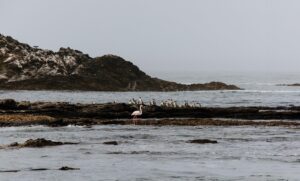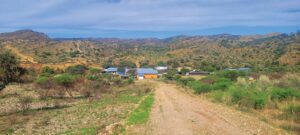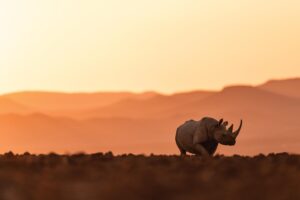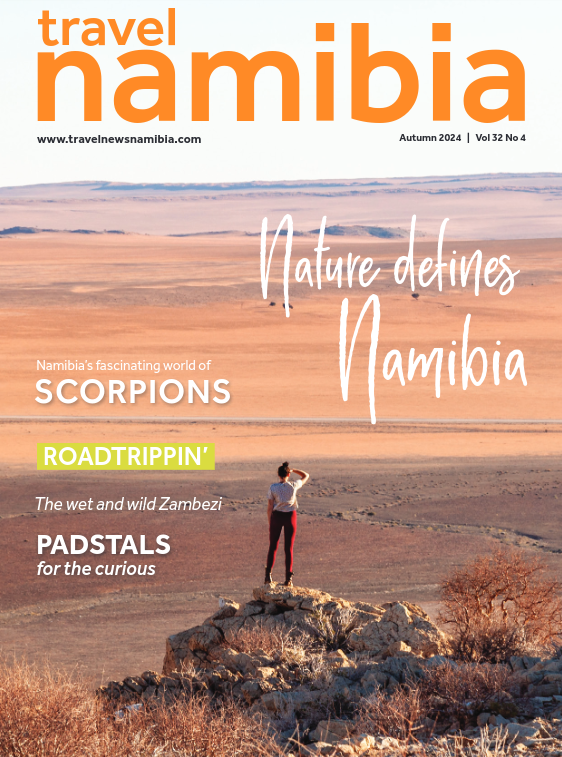
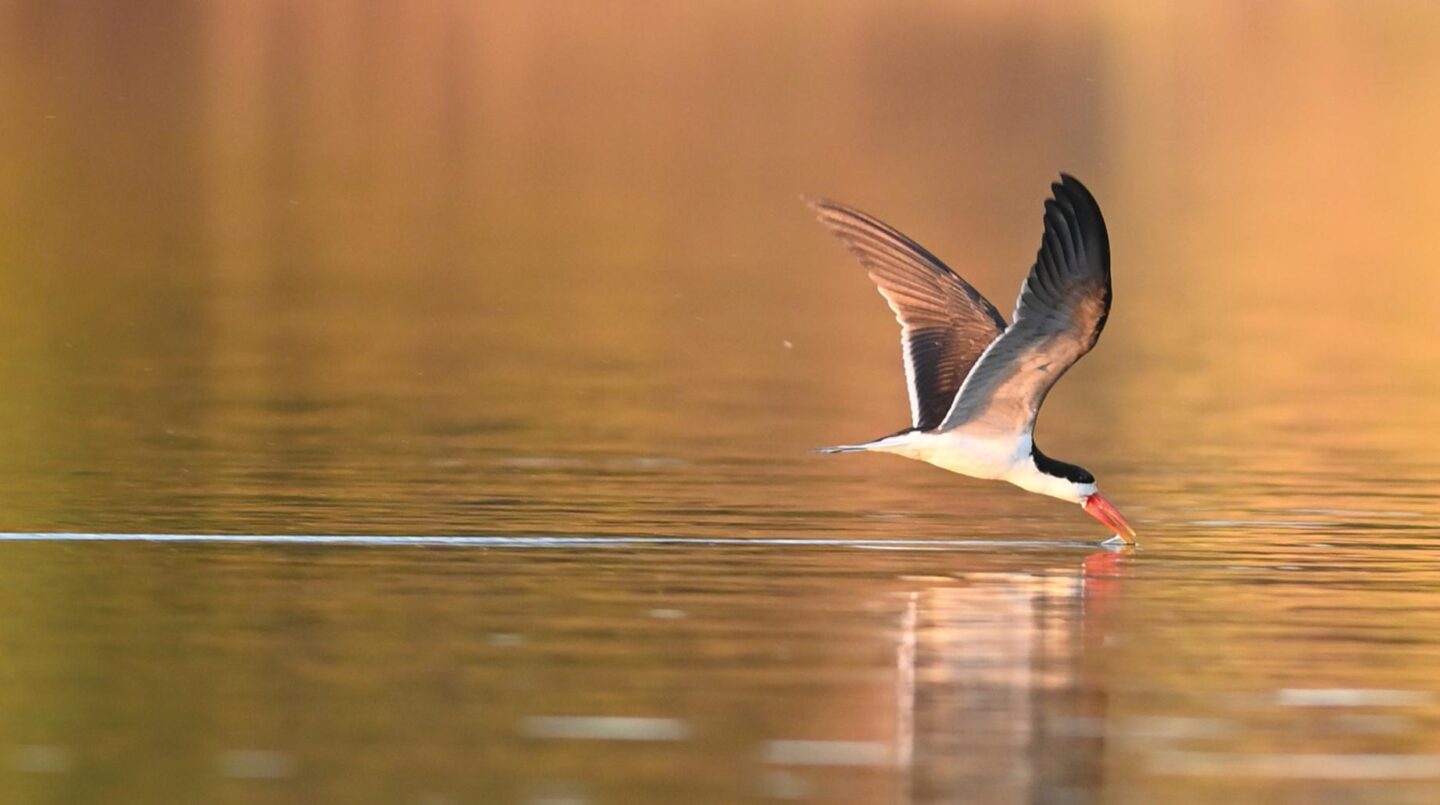
PRACTICE MAKES
PERFECT
African Skimmer. Rynchops flavirostris. Waterploeër.
This is probably the most fascinating bird that occurs in Namibia, at least as far as their hunting/ fishing methods are concerned. They are skimming the water with accuracy and precision with their flexible orange red bill only 2–5 centimetres below the surface for fish that might have the audacity to come up that close. They use their lower mandible, which is longer than the upper one, with hyper-sensitivity to “feel” their target, not seeing it, because most of their fishing takes place at dawn and at night (crepuscular). Within that split second of touching, they close their bill and snatch the fish with immaculate efficacy.
Text Pompie Burger | Photographs Pompie Burger
From the Autumn 2024 issue
Looking at a Skimmer, one might think something went wrong in their creation. A dentist might make the diagnosis of an overbite that needs to be corrected with an osteotomy to shorten the lower mandible. A hunter might suggest a bit of sharpening of the bluntish tip of the lower mandible. An orthopod might suggest leg lengthening with an Ilizarov external fixator for its rather short legs. Going into the development and survival skills, all of the above “scientists” will eventually come to the conclusion that this modified Tern is in fact perfectly created to do its job in an almost perfect construction. The bill, as mentioned, is probably the most perfectly shaped and created for skimming. The legs, which are short in relation to the body, make for balance when skimming: it lets the front part of the body tilt forward sufficiently to give it the correct angle to fly across the water. The long, narrow wings make for an agility in flight matched by very few other birds.
My first encounter with these birds was during the spring of 2010 with the infamous Mark Paxton. I was fortunate to be invited to go with him on a Skimmer ringing expedition in Mahango Game Park. I will not go into too much detail about the wonderful gourmet dinner I prepared for him the night before our expedition, suffice to say that even Mark ate all his food without complaining about the menu or the company.
The next day we went early in the morning to the scene of the crime on a sandbank at the Kavango River. While he started preparing his goodies for the ringing, I took a walk along the river, watching in awe how the Skimmers tried to divert our attention from their breeding spot. Obviously, Mark was not to be disturbed by the constant calling/screaming and dive-bombing around his head. Without much ado about these tactics, he started searching for nests on the bare riverbank and found some without much of a struggle. His excitement was contagious when he caught the first immature Skimmer and started ringing it. Meantime, back on the range, the wind picked up considerately. Our boat was not that securely tied down and as a result started drifting into the mainstream of the Kavango River. Not being the best-known swimmer, and rather uncertain when last the crocodile population had a proper meal, I decided to call Mark. Being an experienced nature conservationist, he just took off his shoes (he does not wear socks) and dived into the river to rescue the boat.
There are only three Skimmer species in the world: the African, the American Black and the Indian Skimmer. There are a few records of the American Skimmer along the Namibian coast. The main difference is the black tip to their bill, compared to the yellow tip of our African Skimmer, as well as the fact that they are coastal birds. African Skimmers are intra-African breeding migrants, arriving late April to early May. Their timing of breeding depends on sandbanks being exposed. Their departure is based on the intensity of the early rains and flooding in late December or early January. In years of drought, some birds remain through the rainy season.
Their breeding grounds are selected with almost scientific accuracy. The timing is important because the eggs must be laid and hatch while the riverbanks are exposed because the water level is going down. By the time the level rises, the chicks must be hatched and ready for their first solo flight. The nest is rather basic: just a small scraping so that the eggs are not visible from the side. Luckily, the spots on the eggs add a bit of camouflage.
The eggs take about three weeks to hatch, after which the chicks are ready to fly within three months. Initially the lower mandible is the same length as the upper bill, but starts growing soon, until it is ready for fishing. When the young birds are still in the paediatric ward, the parents will protect them from predators by performing injury-feigning distraction displays. Because of their small feet, especially the juveniles sometimes land too fast and end up with their bill stuck into the sand. As they grow older, this problem is usually solved. Practice makes perfect, so the sandbanks are the practice pitch where the young do their pilot practice by skimming on the sand.
“Prime areas to find the African Skimmer are along the Chobe, Kavango and Zambezi rivers in places with bare emerging sandbanks, no vegetation and deep surrounding waters”
The survival of the African Skimmer is at risk because of overgrown sandbanks, rising river levels, because of dams built and the development of large water bodies downstream. Add to that the excessive disturbance by tourists and growing pressure from fishermen, fishing nets, livestock like cattle along the river. All of this, and prone to accumulations of pesticides such as DDT, have caused their breeding success to be below 13 percent.
Prime areas to find the African Skimmer are along the Chobe, Kavango and Zambezi rivers in places with bare emerging sandbanks, no vegetation and deep surrounding waters. Skimmers normally occur in small groups and roost communally. The plowing takes place on the sand and the sowing in the water. TN


